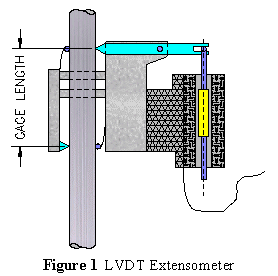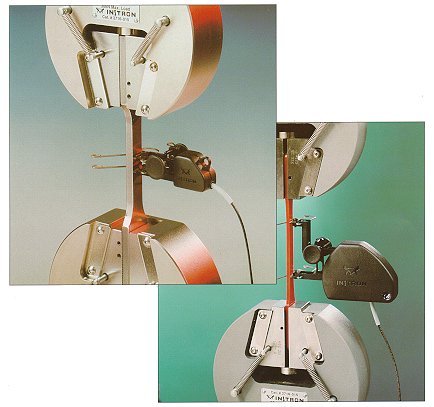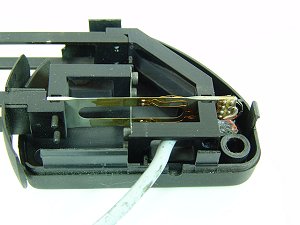Manufacturers

Tension Testing Equipment
|
 |
Universal Testing Machines
Instron 44XX


Tinius Olsen's Super "L" Series

Grip Faces
grips faces for round and flat specimens broken grips due to improper loading
Extensometers
Mechanical Extensometers
Many devices have been made for measuring deformation (or strain). Strictly speaking, since gage lengths are always finite, we measure deformations. While we frequently calibrate our output signal to give average strain over the gage length, we are in reality sensing finite deformation over a finite gage length.
Deformation measuring devices include innumerable devices employing mechanical, optical, electrical resistance, electrical inductance, electrical capacitance and piezoelectric principles. The large variety of devices which have been developed to measure deformations (or strain) is extensive.
Perhaps the most straightforward device for measuring deformation is a simple dial gage. Such gages employ internal gears to translate linear movement of a ram (sensing element) into rotation of a dial. Dial gages can be mounted on an attachment frame to sense deformations of axially loaded members.


LVDT Extensometers
A large variety of deformation measuring devices have been developed which employ change in electrical inductance as the sensing media. The simplest, and most widely used simply employs a small electrical transformer with a movable core. Such devices are called (LVDT) linear variable differential transformers. They are built into an attaching device which causes the core of the transformer to move relative to the coil, as the specimen deforms. The resulting change in impedance of the coil is related to the deformation change.
The electrical impedance Z of a coil is given by

where f is the current frequency in Hertz, L is the inductance of the coil in Henrys, and R is the electrical resistance in ohms. If 2fL is large compared to R then the impedance change is approximately proportional to inductance change.
With proper instrumentation, an output signal proportional to impedance change can be obtained. This signal can be calibrated to give either deformation or strain values.



A typical LVDT extensometer (Figure 1) involves a mechanical frame which clamps to the specimen and mechanically converts deformation of the specimen to core movement of the transformer. These transformers are frequently built into units for sensing large deformations. These larger instruments are called deflectometers and crosshead motion indicators. Gage length possibilities are almost unlimited with gage lengths of 1, 2, 4, 8, 10, and 24 inch readily available off the shelf. LVDT extensometers are particularly well suited for measuring large deformations.
The basic principal of operation of all LVDT deformation measuring devices is the same, but the various instruments may look very different physically. A close examination, however, would show that each employs a moving-core transformer as its sensing element.
LVDT extensometers are versatile and reusable. Their primary drawback is the fact that they require special instrumentation and they are relative bulky. Their size makes them unsatisfactory for many applications, particularly dynamic applications, where their large mass can significantly slow their response to sudden deformations. One of the primary advantages is the fact that the LVDT can be used to measure very large deformations. The gage length and large deformation measuring capability is practically unlimited.
References:
- Engineering Mechanics of Deformable Bodies, by Byars, et.al., 4th Ed. Harper & Row, 1983, Chapter 15, pp 471-484.
- Handbook of Experimental Stress Analysis, by Hetenyi, John Wiley, 1950, pp 160-189.
- Mechanics of Materials, by Higdon et.al., 4th Ed. Wiley, 1985, pp 81-83.
Strain-Gage Extensometers




Enviromental Chambers

